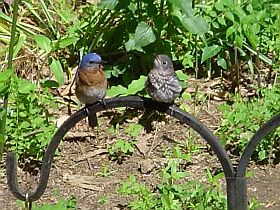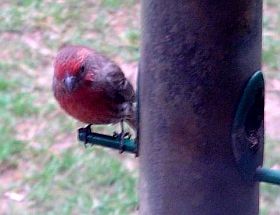
Bluebird parent instructing juvenile bluebird
The parents of recently fledged Eastern bluebirds immediately begin an intensive orientation period, lasting approximately two weeks, for the juveniles. The orientation includes locating suitable food, water, and shelter, as well as, avoiding dangerous situations. If you provide acceptable food and water in your yard, you can expect to see the extended bluebird family (parents and offspring) making the rounds.
Offspring from earlier clutches in the nesting season can often be seen accompanying their parents during subsequent nesting cycles in the same nesting season. By the beginning of the next nesting season, the “extended family” dissolves.
House finches can sometimes be seen tagging along with an extended bluebird family. Eastern bluebirds will tolerate house finches in close proximity during the post-fledging phase and even during the nest selection and building phases of the next cycle.

House Finch (Carpodacus mexicanus)
For some odd reason Eastern bluebirds tolerate the affinity that House Finches develop for them at different points in the nesting cycle.
The House Finch, or Linnet, is originally a species of the Western United States and Mexico. In 1940, wild Finches were illegally released in New York City. By 1943, the released birds were reported breeding in the New York area. By 1971, breeding populations extended along the east coast from New England to North Carolina.
Email me at Bluebird Shepherd if there is a specific topic you would like for me to address in a future article.
Bluebird Shepherd



 Posted by helpforbluebirds
Posted by helpforbluebirds